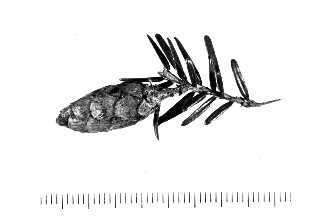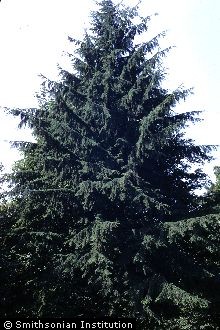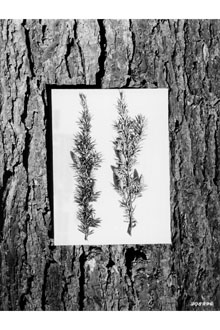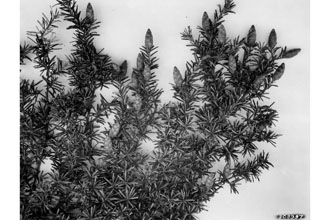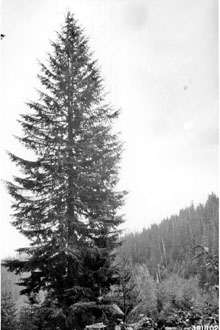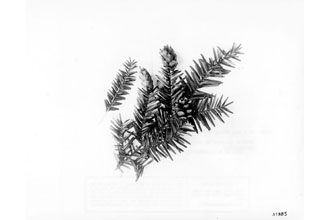Western Hemlock
Scientific Name: Tsuga heterophylla (Raf.) Sarg.
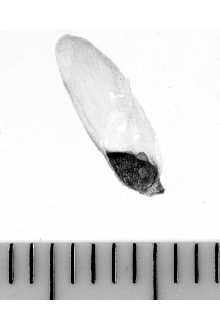
| General Information | |
|---|---|
| Usda Symbol | TSHE |
| Group | Gymnosperm |
| Life Cycle | Perennial |
| Growth Habits | Tree |
| Native Locations | TSHE |
Plant Guide
Alternative Names
West coast hemlock, pacific hemlock, coast hemlock
Uses
Ethnobotanic: Western hemlock bark has high tannin content and was used as a tanning agent, pigment and cleansing solution (Pojar & MacKinnon 1994). Some Coast Salish people used a red dye made from hemlock bark to color mountain goat wool and basket materials and as a facial cosmetic and hair remover (Ibid.). The wood was heavy, durable, and fairly easy to carve. Implements such as children’s bows, spoons, combs, roasting pits, dip-net poles, and edges were carved from hemlock wood. The Mainland Comox threaded oolichan and herring boughs for drying, and used for drying, and used the boughs for lining steaming pits (Ibid.). Kwakwaka’wakw dancers wore headdresses, and head-bands of hemlock boughs, and young women lived in hemlock-bough huts for four days after their first menstruation (Ibid.). Pitch obtained from crevices in the bark, has been chewed as a gum (Ibid.). Western hemlock leaves and shoot tips were used to make an herbal tea. The leaves and young shoots have been chewed as an emergency food to keep one alive when lost in the woods (Ibid.). Medicinal: Western hemlock was commonly employed medicinally by several native North American Indian tribes who used it to treat a variety of complaints (Moerman 1998). Hemlock pitch was applied for a variety of purposes, including poultices or poultice coverings, linaments rubbed on the chest for colds and when mixed with deer tallow as a salve to prevent sunburn (Pojar & MacKinnon 1994). A decoction of the pounded bark has been used in the treatment of hemorrhages, diaphoretic, and diuretic (Moerman 1998). The powdered bark can be put in shoes for foot odor. Charles Webber © California Academy of Sciences @ CalPhotos Landscaping & Wildlife: Tsuga heterophylla is occasionally planted as an ornamental tree in northern states and in Western Europe (Sargent 1961). Western hemlock stands provide cover and habitat for many wildlife species and small mammals. It is also used for nest trees by cavity nesting birds. This species is browsed by elk and deer. The seedlings are eaten by snowshoe hares and rabbits. Agroforestry: Western hemlock is used in forested riparian buffers to help reduce stream bank erosion, protect aquatic environments, enhance wildlife, and increase biodiversity. Economic: It is one of the best pulpwood for paper and paperboard products. The wood is used in house construction for external walls, structural support and is suited for interior finish, kitchen cabinets, flooring, and ceiling.
Status
Please consult the PLANTS Web site and your State Department of Natural Resources for this plant’s current status, such as, state noxious status and wetland indicator values.
Description
General: Western hemlock (Tsuga heterophylla) is a large evergreen tree growing from ninety to two-hundred feet high. The needles are short stalked, flat, finely toothed, irregularly spare, and of unequal length (five to twenty millimeters long). The seed cones are ovoid, short-stalked, brown, with many thin papery scales, stalkless, and hanging down at the end of the twigs. The bark is smooth when young, reddish-brown, becoming darker, and deeply furrowed with flat-topped scaly ridges (Farrar 1995). Distribution: Western hemlock is native in northwestern California, Oregon, Washington, British Columbia, Alaska, Idaho, and Montana (McMinn & Maino 1963). In California, western hemlock occurs near the coast in scattered localities from Del Norte County southward to the vicinity of Elk Creek, Mendocino County (Ibid.). In Oregon and Washington, it inhibits the Coast Ranges and Olympic Mountains, extending eastward to the Cascades (Ibid.). For current distribution, please consult the PLANT Profile page for this species on the PLANTS Web site.
Adaptation
Western hemlock occurs on a variety of soil types, Use soil moisture sensors to measure the soil moisture of Western Hemlock., This species is well adapted to grow on humus and decaying wood, and is also found on mineral soil (Pojar & MacKinnon 1994), This species is very shade tolerant and thrives in full sun and regenerates well under a closed canopy, Western hemlock grows in pure stands or mixed at lower levels with Douglas-fir, silver and grand firs, giant arborvitae, redwood, and hardwood and at higher elevations with noble fir, Alaska cedar, mountain hemlock, western, white, and lodgepole pines (Preston 1989),
Establishment
Propagation from Seed: Seed is best sown in a cold frame in the autumn or late winter. Dormancy is variable with some seed lots requiring cold stratification (Dirr & Heuser 1987). Stratification accelerates and improves total germination and, unless seeds are known not to require pretreatment, cold stratification at 41ºF from three weeks to three months is recommended (Ibid.). Young seedlings should be placed in individual pots, once they are large enough to handle, and allowed to grow in a cold frame. During early summer the following year, out plant seedlings to their permanent locations.
Management
Seedling transplant well when they are 8 to 36 inches tall. However, the best survival rate can be achieved if seedling are transplanted between 8 and 20 inches, this is usually when they are about five to eight years old (Huxley 1992). Transplanting larger seedlings will check badly and hardly put on any growth for several years. This slow growth predisposes the seedling to pest, poor root development and wind throws, and related damage. (Ibid.). Cultivars, Improved and Selected Materials (and area of origin) Readily available from your local nursery. Contact your local Natural Resources Conservation Service (formerly Soil Conservation Service) office for more information. Look in the phone book under ”United States Government.” The Natural Resources Conservation Service will be listed under the subheading “Department of Agriculture.”
References
Britton, N.L. 1908. North American trees. Henry Holt & Company, New York, New York. Dirr, M.A. & M.W. Heuser 1987. The reference manual of woody plant propagation. Varsity Press, Athens. Georgia. Farrar, J.L. 1995. Trees of the northern United States and Canada. Iowa State University Press, Ames, Iowa. Huxley, A. 1992. The new RAS dictionary of gardening. MacMillan Press, New York, New York Lauriault, J. 1989. Identification guide to the trees of Canada. Fitzhenry & Whiteside, Ontario, Canada. MacKinnon, A., J. Pojar, & R. Coupe´ 1992. Plants of the northern British Columbia. Lone Pine Publishing, Canada. McMinn, H.E. & E. Maino 1963. An illustrated manual of Pacific Coast trees. University of California Press, Berkeley, California. Moerman, D. 1998. Native American ethnobotany. Timber Press, Oregon. Pojar, J & A. MacKinnon 1994. Plants of the Pacific Northwest coast: Washington, Oregon, British Columbia, and Alaska. Lone Pine Publishing, Redmond, Washington. Preston, R.J., Jr., 1989. North American trees. 4th ed. Iowa State University Press, Ames, Iowa. Sargent, C.S. 1961. Manual of the trees of North America. Vol. 1. Dover Publications, Inc., New York, New York. Viereck, L.A. & E.L. Little, Jr. 1972. Alaska trees and shrubs. United States Department of Agriculture. Agriculture Handbook No. 410. Washington, D.C.
Plant Traits
Growth Requirements
| Temperature, Minimum (°F) | -23 |
|---|---|
| Adapted to Coarse Textured Soils | No |
| Adapted to Fine Textured Soils | No |
| Adapted to Medium Textured Soils | Yes |
| Anaerobic Tolerance | None |
| CaCO3 Tolerance | None |
| Cold Stratification Required | Yes |
| Drought Tolerance | Low |
| Fertility Requirement | Medium |
| Fire Tolerance | Low |
| Frost Free Days, Minimum | 150 |
| Hedge Tolerance | Low |
| Moisture Use | Medium |
| pH, Maximum | 6.0 |
| pH, Minimum | 4.5 |
| Planting Density per Acre, Maxim | 1200 |
| Planting Density per Acre, Minim | 300 |
| Precipitation, Maximum | 150 |
| Precipitation, Minimum | 38 |
| Root Depth, Minimum (inches) | 36 |
| Salinity Tolerance | None |
| Shade Tolerance | Tolerant |
Morphology/Physiology
| Bloat | None |
|---|---|
| Toxicity | None |
| Resprout Ability | No |
| Shape and Orientation | Conical |
| Active Growth Period | Spring and Summer |
| C:N Ratio | High |
| Coppice Potential | No |
| Fall Conspicuous | No |
| Fire Resistant | No |
| Flower Conspicuous | No |
| Foliage Color | Green |
| Foliage Porosity Summer | Dense |
| Foliage Porosity Winter | Dense |
| Foliage Texture | Fine |
| Fruit/Seed Conspicuous | No |
| Nitrogen Fixation | None |
| Low Growing Grass | No |
| Lifespan | Long |
| Leaf Retention | Yes |
| Known Allelopath | No |
| Height, Mature (feet) | 170.0 |
| Height at 20 Years, Maximum (fee | 40 |
| Growth Rate | Slow |
| Growth Form | Single Stem |
| Fruit/Seed Color | Brown |
Reproduction
| Vegetative Spread Rate | Slow |
|---|---|
| Small Grain | No |
| Seedling Vigor | Low |
| Seed Spread Rate | Moderate |
| Seed per Pound | 297600 |
| Fruit/Seed Persistence | Yes |
| Propagated by Tubers | No |
| Propagated by Sprigs | No |
| Propagated by Sod | No |
| Propagated by Seed | Yes |
| Propagated by Corm | No |
| Propagated by Cuttings | Yes |
| Bloom Period | Mid Spring |
| Commercial Availability | Routinely Available |
| Fruit/Seed Abundance | Medium |
| Fruit/Seed Period Begin | Summer |
| Fruit/Seed Period End | Fall |
| Propagated by Bare Root | Yes |
| Propagated by Bulb | No |
| Propagated by Container | Yes |
Suitability/Use
| Veneer Product | Yes |
|---|---|
| Pulpwood Product | Yes |
| Protein Potential | Low |
| Post Product | No |
| Palatable Human | No |
| Palatable Graze Animal | Low |
| Palatable Browse Animal | Low |
| Nursery Stock Product | Yes |
| Naval Store Product | No |
| Lumber Product | Yes |
| Fuelwood Product | Medium |
| Fodder Product | No |
| Christmas Tree Product | No |
| Berry/Nut/Seed Product | No |

